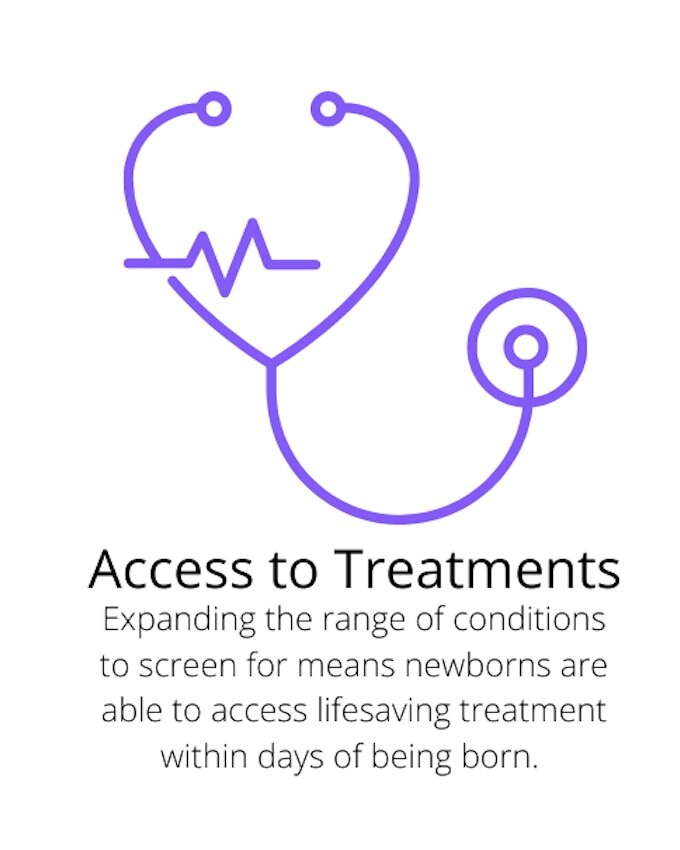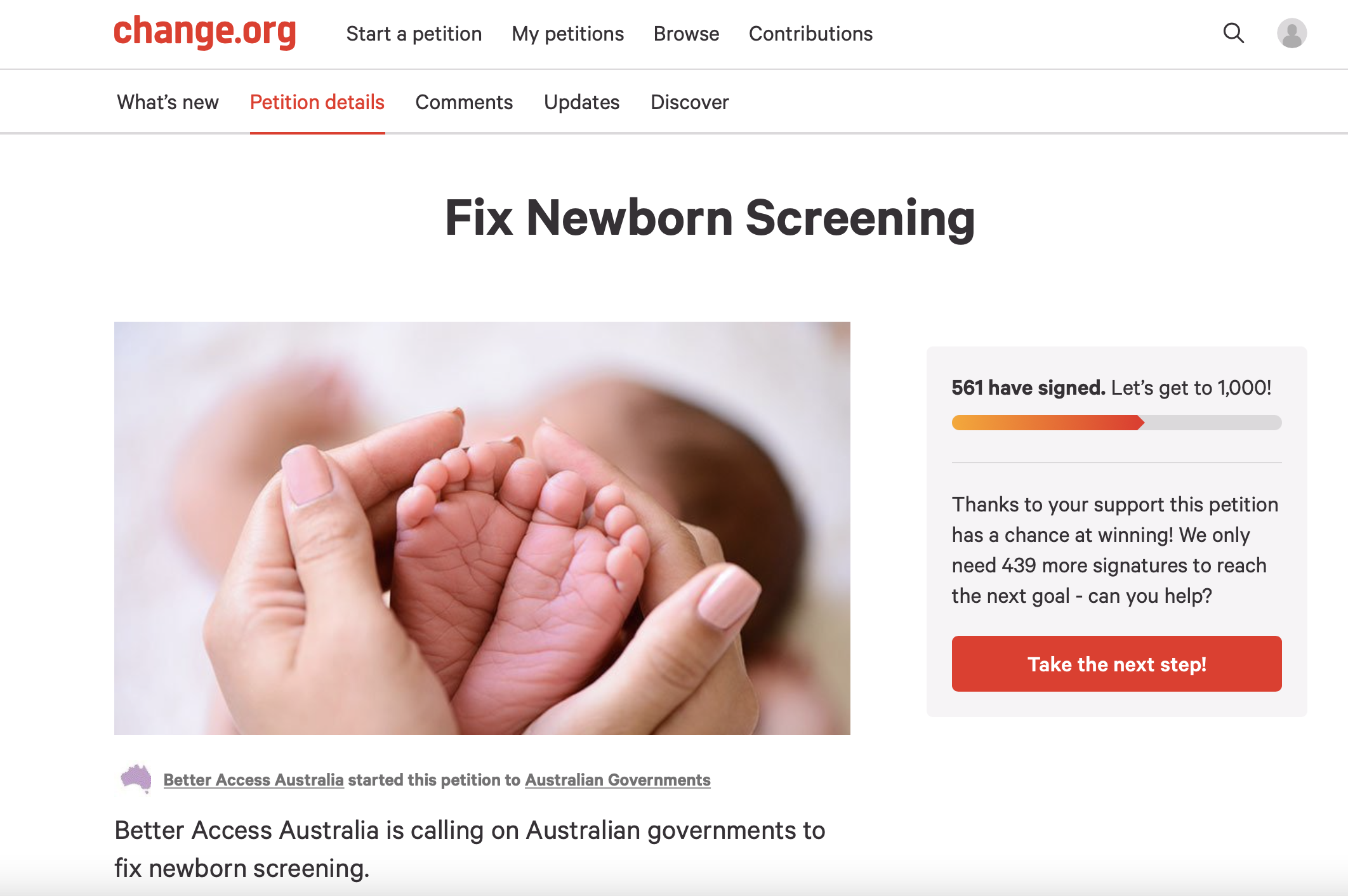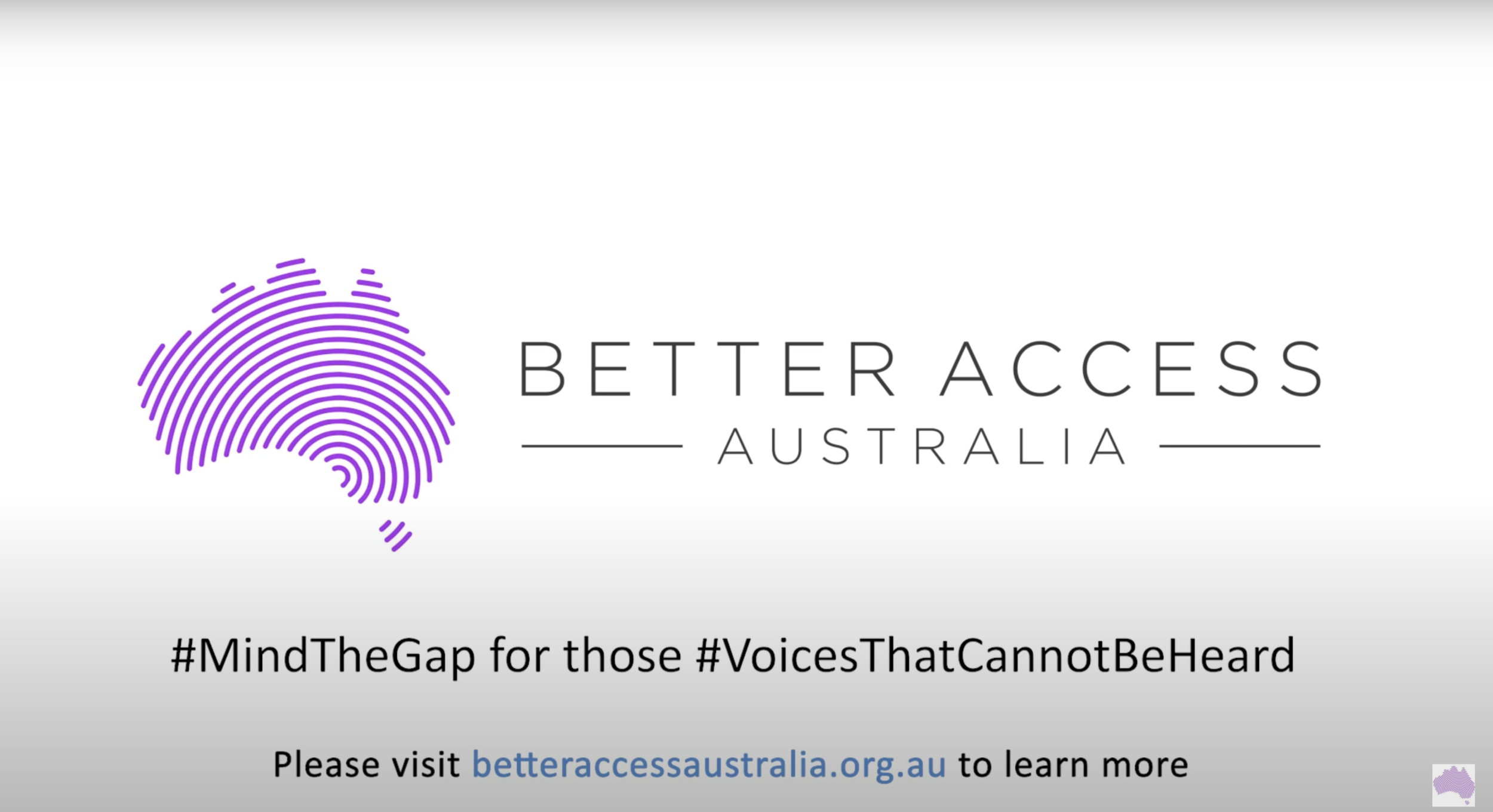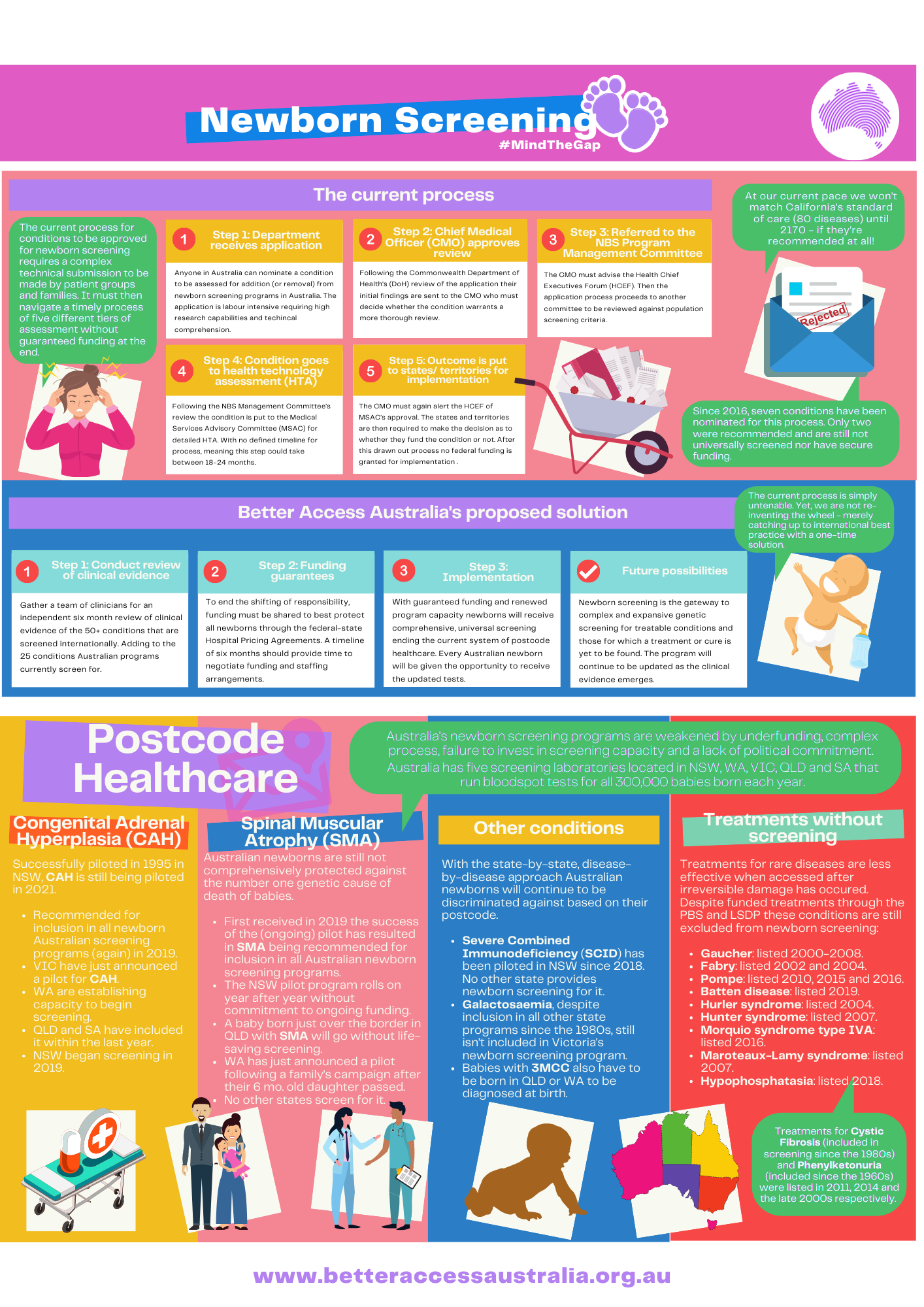
Better Access Australia is committed to fixing Australia’s newborn screening program
#StartOfLife care begins with a national and expanded newborn screening program. Better Access Australia is standing up for the 300,000 children born in Australia every year.
It is time for governments to act on the growing gaps in newborn screening.
Change to newborn screening needs to occur to :
Better support families and newborns at the start of life
Expand the list of rare conditions currently screened for
Ensure that strong and effective universal newborn screening is provided through high-quality and comprehensive access
Adopt next generation screening technology
Bring Australia’s program into line with international best practice, and
Address the current gaps in the system.
Now is the time to stop the political handwringing and inaction to provide newborns with the greatest chance at life.
State and federal governments need to stop passing the buck and instead end this discrimination.
Our health care system needs to offer a start of life approach as much as it prioritises end of life treatments.
Newborn screening in Australia is provided by newborn bloodspot screening (NBS) programs which are run by each state and territory. NBS involves a heel-prick test within 48-72 hours of birth to screen for a host of rare conditions.
Where Australia was once a leader we have since fallen behind international best practice. Programs in the United States, Taiwan and Europe offer examples of advanced programs that Australian newborns and families are missing out on.
Rare diseases such as Pompe, sickle cell disease and spinal muscular atrophy are routinely tested for internationally. Australia, however, leaves our infants unprotected by not updating newborn screening programs for their inclusion. Not good enough.
Screening programs in California screen for over 80 diseases only of which four do not have treatments. Australian programs screen for roughly 25 diseases. We are woefully trailing California screening for less than half the amount of diseases.
A recently announced pilot program in the state of New York will now extend the list of conditions screened for by 14 on top of the 52 that were already included. Further evidence of how far we have fallen behind international best practice.
Pre conception genetic testing is a great step forward but in order to benefit you need to know you have the disease.
Government is spending $95.6m to help 6,800 babies born through IVF yet won’t spend less than $10 to diagnose lysosomal storage disorders including Pompe disease for all 300,000 babies born in Australia every year.
Early diagnosis through newborn screening means timely to access life-saving treatments before irreversible damage has occurred. It also provides the best chance families have for the prevention of disease and access to clinical trials for new and complex diseases such as childhood dementia that are searching for treatments and cures.
Current policies and standards are failing newborns and failing families.
WHAT WE CAN DO NOW TO PROTECT OUR KIDS:
1) Conduct a six-month independent review before the end of 2022 of the clinical evidence of 50+ conditions already approved in the US and Europe to be added to Australia’s newborn screening program, with the goal of bringing the program into the 21st century.
2) Include the funding of the recommended testing in the federal-state Hospital Pricing Agreements. The buck passing between state and federal governments must stop. We need a shared commitment to the future health of babies born in Australia.
3) Include a timeline for inclusion of genetic testing of newborns in these same agreements at a population and individual level, starting with the babies who receive a positive result from a newborn screening test. Newborn screening is the gateway to more complex and expansive genetic screening and Australia must not allow another three-decade gap in its health system to be accepted.
SIGN OUR PETITION AND TELL AUSTRALIAN GOVERNMENTS TO FIX NEWBORN SCREENING
Patient and Family Stories




Our health care system needs to offer a start of life approach as much as it prioritises end of life treatments.
Stay informed
How NBS works?
Hospitals offer free NBS to all babies in Australia;
A nurse takes a bloodspot sample from the baby’s heel within 48-72 hours of birth;
The bloodspot card is sent to a laboratory for screening;
If the result is negative parents will not be contacted;
If the result is positive further actions need to be taken including further testing, immediate treatment and other arrangements.
These tests currently screen for the following rare condition: amino acid disorders, cystic fibrosis, fatty acid oxidation disorders, hypothyroidism and organic acid disorders.
Patient groups fighting for better screening:
Australian Pompe Association provides support for families and patients.
AusPIPS provides advocacy and support for people with Primary Immune Deficiency and associated chronic illnesses in Australia.
CAH Support Group Australia aims to improve the lives of people with congenital adrenal hyperplasia through advocacy, education and support.
CCDR (Centre for Community-Driven Research) listens to the issues that patients, researchers, government, healthcare and industry partners face and develops solutions - through community engagement - to solve those issues.
Childhood Dementia Initiative raise awareness of and researches genetic conditions that lead to childhood dementia.
Immune Deficiencies Foundation Australia are a peak body organisation advocating for people living with a primary or secondary immunodeficiency.
SMA Australia advocated for the addition of spinal muscular atrophy (SMA) screening to NBS programs, timely access to treatments and broader education.
Research on newborn screening:
Research published on the public health importance of newborn screening explores the state of Australian NBS programs, international examples and recommendations. Read more here.
Lysosomal storage disorders (LSDs) can be screened for using newborn screening in order to drastically improve health outcomes for patients. Click here to read about the international inclusion of LSDs in newborn screening programs.
Parents’ perspectives of screening for SMA highlight the benefits for families when screening is expanded for treatable conditions. Read the Lancet report detailing the experience of Australian parents to newborns who were diagnosed with SMA through a pilot screening program.
Further information:
California currently screens for 80 conditions in their newborn screening program. Most of which are treatable. Treatments for genetic conditions vary, ranging from dietary changes and blood transfusions to supplements and medications. In comparison Australian NBS programs screen for less than half this amount.
Why isn’t Australia a leader in newborn screening?
The Human Genetics Society of Australasia is an organisation that explores the role of genetics in Australia and New Zealand.
In 2019, they published their recommended list of conditions to include in newborn bloodspot screening programs.
Why are we not screening newborns for conditions that have treatable interventions?
The Recommended Uniform Screening Panel (RUSP) is the body in the United States that recommends the inclusion of genetic conditions for screening to the states.
They have flagged 61 conditions for newborn screening.
Why are we so resistant to the inclusion of more conditions for newborn screening in this country?
Check out list of published evidence reviews by the RUSP on their website.





